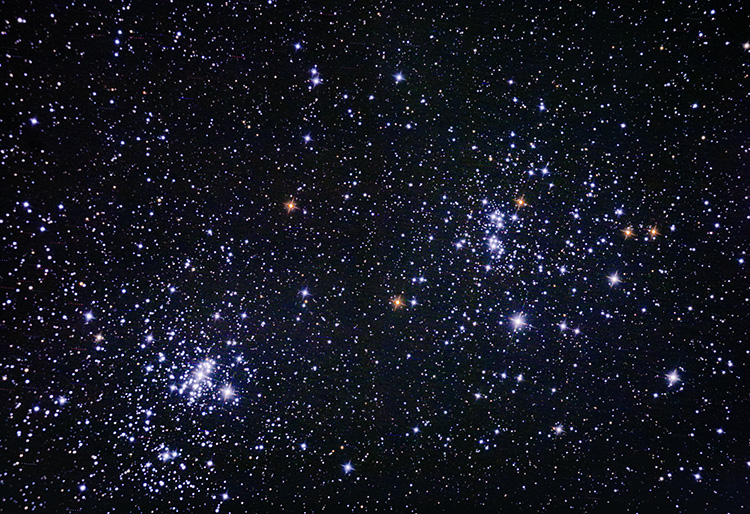12/13/2012. The Geminids built toward a spectacular peak this year, and the weather and Moon cooperated to produce a sparkling, cloudless sky. At twilight, I munged together a piggyback mount for the 10-inch R-C which I used to mount the Canon 5Dc with the 14mm F2.8 Rokinon lens. This I wrapped in a heating pad against frost and powered through a Canon AC adapter to collect light all night long.
About 85 five minute exposures, F2.8, ISO 1250, caught at least three nice Geminids, all within a one hour period beginning just before 1:00 AM. I saw one of them which was probably -2. I gather that the others must have been similar. There may be more, but these are the three brightest (four... tiny fellow at far left, same altitude as Jupiter, ducking into the pines). The severe color gradients might be better handled, and the downsampling for web display seems a little crude, but here's a first look at my three best catches, layered into a single image:
Orion is in the trees, brilliant Jupiter at right just above the Hyades, the sapphire Pleiades above and right of Jupiter. The winter Milky Way runs toward the upper right accented by the brilliant Alpha Persei association and the Double Cluster.
12/19/2012. More experiments under the stars, this time with the 5D behind the AT10 at its native focal length. Interestingly enough, both the fields shown in detail below are visible in the widefield frame above. The Double Cluster is near the upper right corner of the wide-angle photo; the Great Nebula in Orion is in the center of Orion's sword, shown through a gap in the pines near the bottom center.

The Double Cluster in Perseus: Forty-five, 30-second unguided exposures at ISO 1600, aligned and stacked (sigma clip to reduce noise) in Maxim DL. I first converted from RAW CR2 to downsampled 2048 pixel, 16-bit TIFFs using BreezeBrowser and did subsequent processing on the smaller files. Color in the stacked image was anemic, so I selected one good frame and used color data from it.
I installed a right-angle polar scope from Astro-Physics and adjusted it to mark my present pretty-good polar alignment. Then I messed up the mount's alignment on purpose. Then I dialed it back in using the polar alignment 'scope. Then I made this shot using several unguided 30s subs with the 5D:

The Orion Nebula and environs is also a Canon 5D photo made at the 1,989mm native focal length of the AT10RC (13x30s, ISO 1250, unguided). The curious crop is because I started with the target completely hidden behind the tops of some pines and let it track out into the open. I treated the thirteen clearest images as I did those of the Double Cluster. There were some bizarre gradients superimposed over the field by changing tree shadows. Rather than try to fix them all, I did what I could and cropped out what I couldn't.
Sooner or later, I'll do a meticulous drift-alignment and reset the push-pull bolts that set the polar 'scope's aim and make that alignment reproducible.
Except where noted, deep-sky photos are made with an SBIG ST2000XM CCD behind a 10-inch Astro-Tech Ritchey-Chretien carried on an Astro-Physics Mach1GTO. The CCD is equipped with Baader LRGB and 7nm H-a filters. The internal guide chip of the CCD most often keeps the OTA pointed in the right direction (I'll let you know when a Meade DSI and a separate OAG or guidescope takes its place). Camera control and guiding are handled by Maxim DL 5.12. The stock focuser on the AT10RC has been augmented with Robofocus 3.0.9 using adapters turned on the lathe downstairs. Maxim performs image calibration, alignment, and stacking; Photoshop CS4 and FocusMagic 3.0.2 take it from there. Gradient Xterminator by Russell Croman and Astronomy Tools by Noel Carboni see their share of work, too. Beginning in May 2013, PixInsight has taken over some of the heavy lifting for transfer function modification and deconvolution.
:: top ::